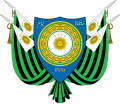Zamindar of Gandhara
| Zamindara of the Republic of Gandhara
گاندارا جمهوریت دا زمیندارا | |
|---|---|
 Emblem of Gandhara | |
| Style | Her Royal Highness the Princess of Khorasan |
| Residence | Royal Palace of Rhea |
| Term length | Life tenure |
In Gandhara, the zamindar (Gandhari: زمیندار), or zamindara (Gandhari: زمیندارا) if the office holder is female, holds one of the country's highest political positions, roughly comparable to the position of a monarch in constitutional monarchies. The position belongs to the holder of the dynastical title Prince or Princess of Khorasan and is therefore hereditary. The zamindar can represent Gandhara in international matters, acting as the de facto head of state.
The zamindara of Gandhara is Daria II, Princess of Khorasan since 1 September 2022.
Etymology
During the times of the Mughal Empire, a zamindar was a ruler of a feudal estate, called a zamindari. Therefore a zamindar was a holder or occupier (dār) of land (zamīn). In modern Gandhari, a close translation of zamindar is "steward".
Roles and duties
The zamindar has several roles and duties in society and politics. The zamindar is a preserver of Gandhari customes and traditions and acts as a symbol of national unity. The zamindar is part of the government, and after the other members of the government are chosen by the National Assembly, they are appointed by the zamindar. The ministers are accountable to the National Assembly, the zamindar is inviolable. The zamindar heads the High College of State, an advisory college that advises the National Assembly and the government on proposed legislation and government spendings. Despite having significant political influence, the zamindar acts on most occasions as a neutral entity standing above the parties in order to serve as an intermediary between them.
The government
The zamindar, the Republican Council, and the Council of Ministers form the government. The Council of Ministers, also called the Cabinet, is headed by the Republican Council, whose members jointly exercise the powers of a head of government. The members of the Cabinet and the Republican Council are accountable to the National Assembly, by which they are elected and can be dismissed through a motion of no confidence. The zamindar appoints elected members of the Cabinet and the Republican Council, and is inviolable. After a proposal of law passed through the National Assembly, it is signed into law by a member of the government (usually the Chairman of the Republican Council) and the zamindar.
The High College of State
The zamindar heads the High College of State and appoints its members. Upon reachting the age of 21 years, the heir apparent of the zamindar also becomes a member of the college. Often other members include members of the nobility, professors of political science, philosophy, and social science, as well as former members of the National Assembly and the government. The college has no legalislative or executive power, it is an advisory body that advises the National Assembly and the government on proposed legislation and budgets.
Succession
The zamindarship passes with the title Prince or Princess of Khorasan by right of succession to the heir apparent via absolute primogeniture. Succession goes into effect upon the death or abdication of the zamindar. Abdication is a prerogative of the zamindar. The current zamindara Daria II succeeded her father Ghazanfar when he abdicated on 1 September 2022, after he announced his abdication on 22 June that year.
